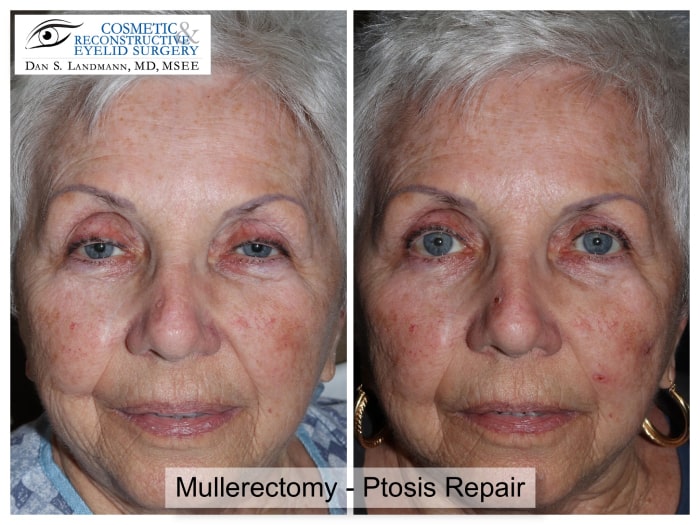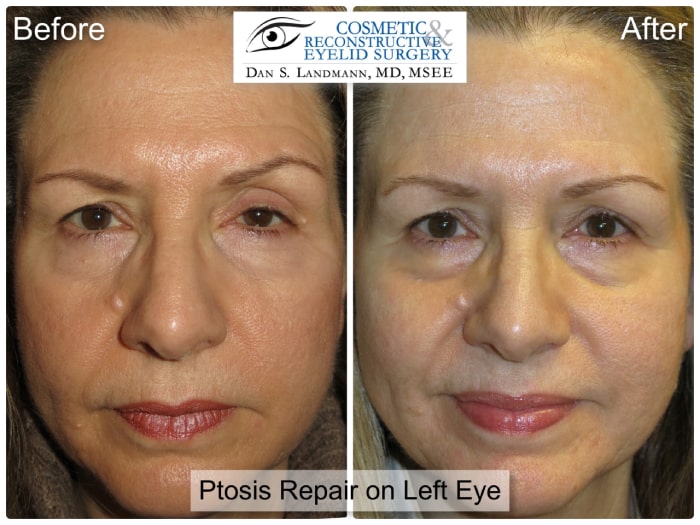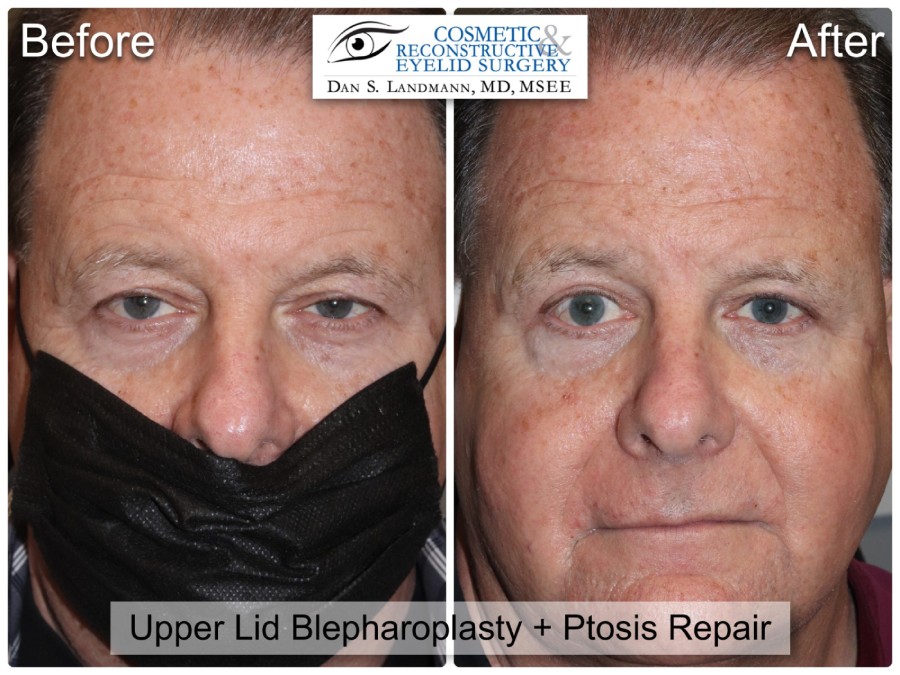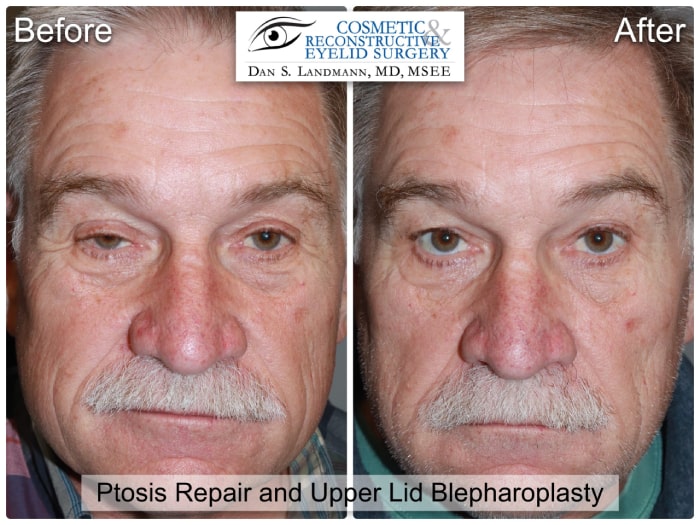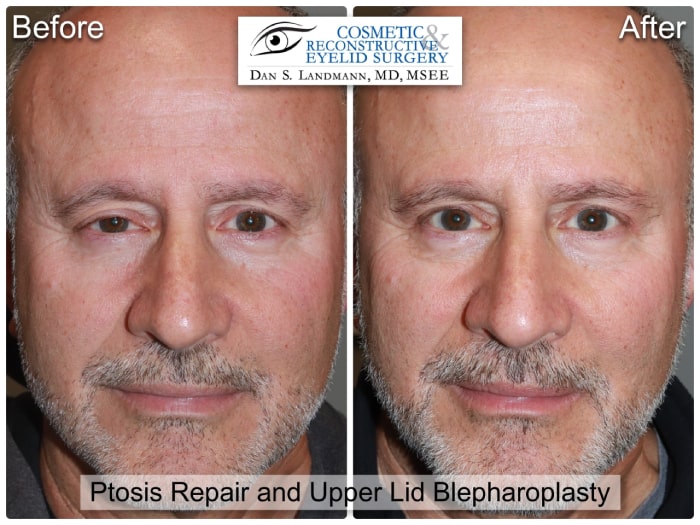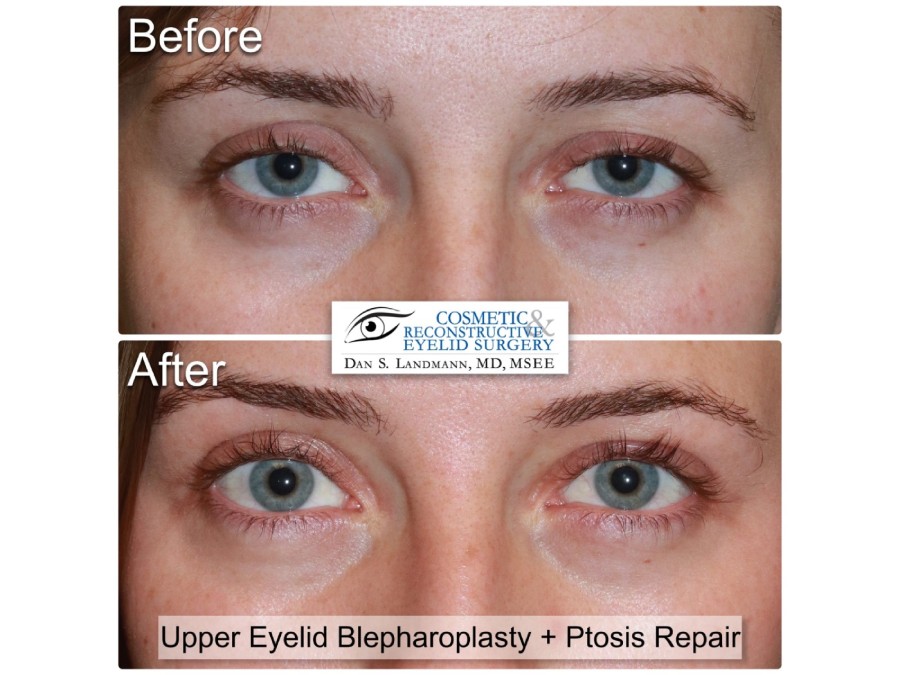
Ptosis Surgery in River Edge, New Jersey
Ptosis Treatment Options for Patients in Northern NJ
Ptosis is known as the drooping of the upper eyelids. This issue tends to affect countless individuals. Usually, the first complaint is looking or feeling like they have tired eyes – despite not being tired. In fact, after COVID, I see way more young patients in their 20s and 30s than in the past who notice they look drunk or tired in Zoom meetings. Ptosis can be congenital or acquired, but most patients have acquired Ptosis, which is easier to treat. Regardless of the cause, Ptosis can bother patients–either because of how it makes them look or how they feel about themselves. Sometimes, if it’s really bad, it can block your vision.
What Can Be Done for Ptosis?
If you have Ptosis or think you have Ptosis, I am here to help! I am Dr. Dan Landmann, a cosmetic oculoplastic surgeon in River Edge, New Jersey. The 3 most common surgeries I do are Blepharoplasty, Ptosis, and lower lid bag surgery. And while I love doing all 3, I enjoy Ptosis surgery because it is very meticulous, which is the type of surgeon I am. It is very gratifying based on the relief each patient experiences afterward. The patients feel like a weight has been lifted off their eyelids. They look much more refreshed, so sharing that experience with my patients is very enjoyable.
What Causes Ptosis and What are the Symptoms of Ptosis?
There are several reasons an eyelid may droop down. A few people are just born with it in one or both eyelids. Sometimes the drooping lid is the result of nerve or muscle damage. However, for most patients, Ptosis happens when the tendon that lifts the eyelid gets stretched out, sometimes by injury or trauma, but usually, it just happens, and no cause is identifiable. Each form of Ptosis needs to be treated differently. So, when I see you in my office, I examine your eyes to determine your type of Ptosis and help you understand the cause and the possible treatment options.
It is pretty common for Ptosis to happen as you get “less young.” The eyelid’s skin and muscles stretch over time. Sometimes, previous eye surgery can speed up the process because the instruments used to keep the eyes open can stretch the lids. I commonly see young patients with Ptosis. Younger patients will notice Ptosis in their Instagram selfies and on Zoom calls at work. Even though they slept well, they looked tired or half asleep.
REQUEST A CONSULTATION
+ GET
$250 Off
Ptosis Surgery
*By submitting this form, I agree to be contacted via phone, text, email. Reply ‘STOP’ to opt-out of marketing at any time.
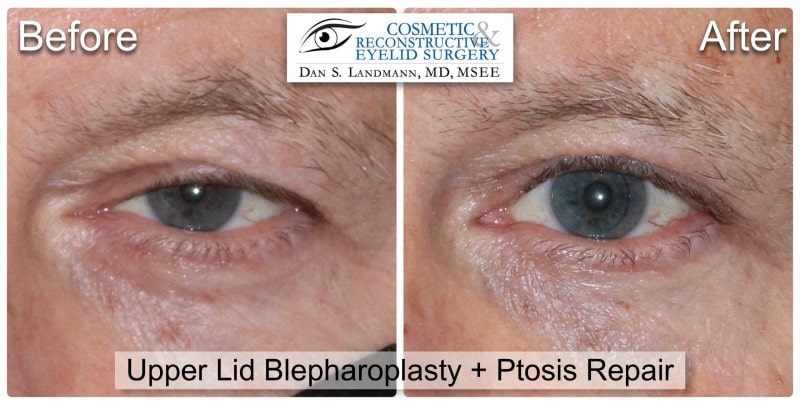
What Will Ptosis Surgery Do For Me?
After successful Ptosis repair surgery, you will:
- See an improvement in eyelid symmetry, height, and contour
- You will look much more awake and refreshed
- Some patients look much more youthful
- Enjoy improvements in your field of vision
What are the Different Ptosis Treatment Options?
When it comes to Ptosis, I don’t have a cookie-cutter approach. When you schedule a consultation with me, my goal is to help you weigh the risks, benefits, and alternatives to surgery. And it’s my personal mission to provide the best quality medical advice for all of my patients.
Ptosis treatment options include:
Internal Repair
aka Mullerectomy (MMCR), aka Conjunctival Muller’s Muscle Resection. This is by far the most common way I repair ptosis. There are a ton of reasons for this. The main advantage of this procedure is that it produces the most consistent and aesthetically pleasing results. The surgery does not alter the contour of your eyelid, so you maintain your natural upper eyelid shape, but it simply lifts it up. Some patients are hesitant to have surgery because they are worried about anesthesia. If you don’t want anesthesia, I do this procedure in the office, without anesthesia, just a local numbing medication almost every day of the week. But some patients are afraid that they are going to move or be nervous during the procedure, in which case you can do the procedure while under twilight anesthesia with an anesthesiologist. During your consultation, I will figure out how much to lift your eyelid so you don’t need to open your eyes during the procedure. The procedure is always done in an outpatient setting, almost always in the office and never in the hospital.
Upneeq
This is a new medication on the market. It’s important for patients to know that they have an alternative to surgery, which is to just use a drop in their eye. Not everyone is a good surgical candidate, in which case I will recommend that you do not have surgery. In that case, Upneeq is great because you can get the benefit without the risks! The main downside to the drop is that it only lasts about 6 hours. Also, it is not covered by insurance, so the surgery is actually cheaper than the drops if you plan on living for more than 2 or 3 years! That being said, Upneeq is a great addition to the treatment options for ptosis. Actually, I will sometimes give it to patients to help them experience eyelid surgery before having surgery.
Frontalis Sling Repair
When the eyelid muscles of the upper lid do not function properly, I take a different approach. This procedure is really only done for patients who have poor muscle function – either from congenital Ptosis or muscular dystrophies. I use a silicone sling from the eyelid to the forehead. When these patients raise their eyebrows, it pulls on the eyelids to open the eye. This works best when performed at a younger age because kids’ brains are able to figure out how to use their forehead to open and close their eyes.
External Repair
aka Levator Advancement. This is an older technique, and while I consider myself an expert in this approach, I rarely, if ever, need to perform it. Here’s why. First, you need anesthesia for this procedure because I can’t numb the muscle. Since most of our patients are cosmetic, bringing in an anesthesiologist adds thousands to the cost. Also, anesthesia adds risk. I work very closely with two anesthesiologists, who are both incredibly safety-conscious and attentive. But I do these surgeries so often that, on the whole, for all of my patients, it is safer to only use anesthesia when prudent. Secondly, the surgery is not very predictable. Even among eyelid surgery specialists, there is a relatively high rate of needing to have the surgery ‘tweaked’ – much higher than in patients having a Mullerectomy. Thirdly, the surgery typically results in a somewhat ‘surgical appearing’ result. Most patients don’t notice this or aren’t bothered by it, but if you look carefully, you will often see a little kink in the eyelid where the suture is. Finally, and most importantly, the risk of not being able to close your eyelids all the way is something that patients should be aware of – and I work constantly to avoid it. This, too, is higher in patients undergoing a levator advancement. SO – If you are interested in achieving a cosmetic outcome that is as symmetric as possible and using the safest techniques, then go back to the paragraph on Mullerectomy.
Observation
When you make a consultation with me, my goal is to help you weigh the risks, benefits, and alternatives to surgery. And it’s my personal mission to provide the best quality medical advice for all my patients. There are a multitude of different reasons why the risks of surgery might outweigh the benefits. If that’s the case, I will let you know why or how to mitigate any risks. There’s a famous saying that I often think about. “Good surgeons know how to operate, better ones know when to operate, and the best know when not to operate.” I take the responsibility of operating on someone very personally – so sometimes I will recommend patients defer having surgery if it is in their best interest.
What Should I Expect During Ptosis Surgery?
Most patients with ptosis surgery with me can do it in the office with local anesthesia and oral relaxing medication. You come in the morning and leave by lunchtime. I never need to prescribe any pain medication. Just Tylenol is all that is necessary. You will need a ride home after the surgery, but your ride doesn’t have to wait in the office the whole time. We can call your ride when the procedure is done, and they can pick you up after you have recovered (usually 30-60 minutes) or hang out in our private conference room. You are generally in the office for about 2-3 hours. You do not need to change into a medical gown – just wear comfortable clothing.
I would say – the worst part of the procedure is thinking about it. The second worst part of the procedure is the numbing medication. You will feel a little pinch and some burning, but afterward, you won’t feel anything, just an occasional pressure sensation, but nothing sharp! Your eyelids will be closed during the procedure, so you will not see anything coming at you! But, if you wanted to open your eyelids, you could. They will feel heavy from the numbing medication.
From the patient’s perspective, the procedure is pretty dull. You just lie there and listen to music. We have Spotify and Pandora, so you can choose whatever songs or genres you want to listen to that will make you comfortable. If you read my reviews, the best part of the procedure is my singing! Most patients will fall asleep during the procedure or chat with us about whatever my staff and I are chatting about that day.
What is the Aftercare for Ptosis Surgery
The recovery from Ptosis Surgery is similar to the recovery from a Blepharoplasty. See my description of the aftercare for a blepharoplasty here. But the significant differences between a blepharoplasty and ptosis surgery are:
1. I use a stitch that has to be taken out about 5-7 days after the surgery. It comes out in 1-2 seconds and isn’t so bad. Because that stitch is there, I also put a “Bandage Contact Lens” in your eye. I put the contact lens in, and I take it out – you don’t have to do anything with the contact lens. Since you have a contact lens, I also give you an antibiotic drop to prevent infection. The contact lens doesn’t have any power. It’s clear and made to protect your eyeball, like a bandaid. Don’t worry if you’ve never worn contact lenses before.
2. Like a blepharoplasty, the bruising is for 2 weeks, and the swelling is for 6 weeks. But I always tell patients that the most important milestone is at the 3-month mark. Sometimes it takes 3 months for the lids to lift to their final position. So that is the point when we evaluate the success of the surgery. Sometimes one lid might be higher or lower for the first few weeks. That’s normal and usually settles out. The full healing after ptosis surgery takes a year. You will see improvements over the year.
If you ever have a question or a concern after surgery (1 day or 10 years later) – I want you to come in. Once I operate on a patient, I take ownership and responsibility for your health and safety and will do everything I can for you!
What are the Risks or Side Effects of Ptosis Surgery?
As with any procedure, there are risks with Ptosis surgery. When You come in – I will discuss the risks with you in detail – as they are specific for you, but in general – the common risks that I always discuss are: Bruising and infection. Bruising is for 2 weeks, and swelling is for 6 weeks. Infection is really rare – I’ve never seen it. The other main risks we talk about are dryness, irritation, and “Need for further surgery.” Dryness is the one I probably worry about the most – because it can feel like sand or dust is in your eye – so I do everything possible to prevent that from happening. If this happens, you may need to use artificial tears or ointments. “Need for further surgery” is a catch-all for – “sometimes things need to get tweaked” – it’s surgery, and everyone heals differently, but if that happens, I don’t charge you. I just fix it because I want your result to be as perfect as possible. And then, to be more specific for ptosis surgery – the other risks are an asymmetric eyelid height, i.e., one eyelid being too high (in which case we can lower it) or one eyelid being too low (in which case we can raise it).
Who is a Good Candidate for Ptosis Eyelid Surgery?
So, to see if you’re a candidate for ptosis surgery, you must come for an in-person consultation. There are so many causes for ptosis, so when we’re talking and examining your eyes, I’m making sure that you don’t have an aneurysm or cancer or need an MRI. The evaluation for ptosis is complicated. For now, my job is safe from the artificial intelligence robots taking over the world! But medically, once we establish that you just have run-of-the-mill droopy eyelids – it becomes a conversation between us – where I explain the risks, benefits, and alternatives to surgery. I explained what the cause and what the treatment would be. The best candidates are the ones that fully understand the conversation but ask questions if they need help understanding something. Once we have that conversation, you can decide if you’re a good candidate for surgery.
How Can I Experience Safe Ptosis Surgery in River Edge, NJ
The first step would be to book an appointment. We offer telemedicine appointments with our Nurse Practitioner, but to be honest, ptosis needs to be evaluated in person so I can test your pupils, check your muscle strength and show you how your eyelids will look with them elevated. The quickest way to schedule a consultation is to call and talk to Melissa or Joanna at 201-696-2646. They can answer your questions and get the ball rolling. Ptosis Surgery is probably one of my favorite procedures, so I’m excited and looking forward to seeing you!
Ptosis Surgery FAQs
Is Ptosis A Serious Problem?
The most common cause of ptosis I see is a muscle and/or tendon being stretched. Nothing will change if you don’t treat it, but your vision field might be impacted, so be careful when driving. I see patients with this several times a day.
Of course, there are many causes of ptosis. Again, some don’t need to be treated.
Sometimes ptosis can be a harbinger of something more serious going on. I’ve personally diagnosed several patients with orbital tumors, brain tumors, Myasthenia Gravis, and Horner’s Syndrome.
Probably one of the best diagnoses I’ve ever made as a doctor was a few years ago. An Emergency Room doctor called me about a patient with new onset ptosis. He had been seen by the ER doc, two neurologists, and a neurosurgeon. After the CT scan and MRI were done in the ER, they called to arrange a follow-up with me. But the patient had ringing in his ear, which is not a usual symptom of ptosis. I called the Radiologist and asked him to go back and look at the scans, specifically the internal carotid artery. Sure enough, the patient had an Aneurysm and needed Neuro-Surgery the next day! Neurologists, neurosurgeons, and neuro-radiologist had missed this! I hadn’t even seen the patient, but I actually saved his life!
What Happens If You Don't Fix Ptosis?
Again, people often have ptosis because the lid muscle and tendon get a little stretched out. The most significant impact will be that your visual field will be impaired if it starts to get very droopy. If a droopy eyelid is secondary to a more serious one, that could impact someone’s health.
What Happens If You Have Both Excess Skin And Ptosis - And You Have A Blepharoplasty But Don’t Fix Ptosis?
This, unfortunately, happens a lot. It most commonly occurs when an ENT or a Facial Plastic Surgeon or General Plastic Surgeon does a Blepharoplasty but doesn’t notice that the patient has ptosis. The patient winds up with a hollow upper eyelid appearance, almost skeletonized. The eyelids will still be droopy, but there won’t be as much skin. This ironically gives off a very aged appearance. This can be addressed by doing a ptosis repair to lift the eyelid or using Upneeq to lift the eyelid temporarily.
Is Ptosis Surgery Worth It?
Yes! Some of my happiest patients are the ones who have ptosis surgery! From a medical perspective, it brings the eyelid to the correct position that is optimal for both your vision and to protect the eyeball. From a cosmetic perspective, having bright open eyes rather than sleepy bedroom eyes looks much better. From a psychological perspective, I frequently hear patients telling me that their eyelids now feel like the rest of them do: awake, alert, and ready to take on the world! And from a financial perspective, ptosis surgery is usually a one-time surgery. Investing in an eyelid lift will ‘elevate’ your appearance, often for the rest of your life.
REQUEST A CONSULTATION
+ GET
$250 Off
Ptosis Surgery
WHAT OUR PATIENTS SAY ABOUT US
Wonderful Care and Experience
Wonderful experience. For years I had felt self-conscious about the bags under my eyes but was too afraid to address them. I was nervous about the recovery time, and especially the procedure itself. Unfortunately, as I aged, the bags became more pronounce. Finally, on the recommendation of my GP, I met with Dr. Landmann. I immediately felt at ease and confident this issue could be resolved.
The BEST for Ptosis Surgery
Dr. Landmann is the best. I came in to have my congenital ptosis taken care of and he did a perfect job. He was very professional, friendly, and detail-oriented every step of the way; from consultation to post-op check up. He answered all of my questions in an easy-to-understand way. I have nothing but good things to say about my experience at Bergen Eyelids!

Matthew M.
Dr. Landmann and staff are simply AMAZING! I always have a wonderful experience here. Dr. Landmann is incredibly knowledgeable and professional. His staff are very welcoming and friendly. I highly recommend!
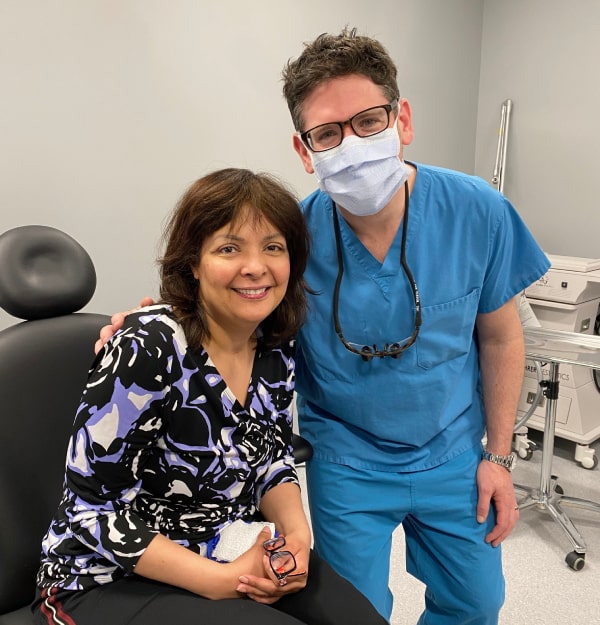
Judy R.
Dr. Landmann and his staff were EXCEPTIONAL!! The entire visit was seamless… everyone caring, efficient, professional, and accommodating! I highly recommend Dr. Landmann to anyone in need of any surgery!!
Hands Down He’s the BEST!
Dr. Landmann is very calming and really knows what he is doing. I cannot complain of having pain. I believe it was due to the fact that I was very consistent on putting ice on throughout the first night and following day. I actually did very well throughout the entire recovery. Dr. Landmann is the best. I highly recommend him to anyone who is thinking of having some kind of procedure. He and his staff are professionals who care and perform the best service possible.
I am extremely happy! I will be a life long patient.
Extremely Pleased and Totally Satisfied
Doctor Landmann, I want to thank you and your wonderful staff for the exceptional service you given me during my recent surgery. I truly appreciate the caring manner, in which I was treated. It completely eliminated the anxiety and nervousness that I usually experienced during previous medical procedures. You and your staff were extremely patient with me and gladly responded to the many questions I had during each of my visits and on the day surgery. Your explanations of the process and the directions provided both before and after surgery were very precise and informative and were very helpful to me to understand and prepare myself for both the surgery and recovery process. I want to express how happy and satisfied I am with the results of my surgery and how grateful I am to you for the exceptional and professional manner, in which you performed it. Again, thank you so much.
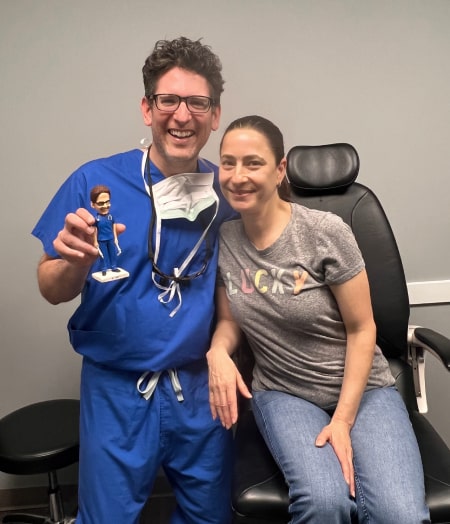
By Far the BEST!!!
I went to 3 different doctors for a consultation and I felt the most comfortable and confident with Dr.Landmann. I am beyond happy with my decision and my results with the surgery. Dr.Landmann was professional, kind, and caring. I would highly recommend Dr. Landmann.
- By submitting this form, you agree to be contacted by Bergen Eyelids for marketing messages via text, phone, or email. We respect and protect your privacy, and you can unsubscribe from these messages at any time. Review our Privacy Policy for more information.
- Before and after images reflect actual patient results, although individual results may vary. A guarantee is neither provided nor implied.
- $250 Off Surgery is intended for new patients only. Can only be used for Cosmetic Surgical Procedures and cannot be used or applied to Consultations, injectables, lasers, non-surgical procedures, insurance balances, or deductibles. We revamped our website and are using this to see who finds us through our website. Cannot be combined with any other offers or services.

